Each month, thousands of people search for “backlink checker” in Google:

We currently rank #1 for this term (and many others) with our free backlink checker:

This helps to generate demand for our products because our free backlink checker is a free version of our premium tool.
In this guide, you’ll learn:
Demand generation is the process of building awareness and interest for your products or services. Any marketing tactics that help you achieve this are methods of demand generation.
Demand generation is important because people need to be aware of and interested in what you’re selling before they can consider buying it.
If you’re familiar with the buyer’s journey, you’ll already know this because awareness and interest are the first two stages:

If that sounds confusing, think about how TV ads work…
Apple doesn’t waste its 30-second slot telling how much each new iPhone costs. Instead, it explains what’s new, how it will impact your life, and how it will make you feel. In other words, it creates awareness and interest for the new model.
This. Generates. Demand.
It’s only after you demand the new iPhone that you might consider walking into an Apple Store to buy one.
The difference between demand generation and lead generation is that although both focus on creating awareness and interest for a product or service, lead generation also captures the information of interested people so you can follow up with them.
For example, this podcast episode with our CMO, Tim Soulo, generates demand but not leads—at least not directly:
https://www.youtube.com/watch?v=g9OoGwLgXWA&ab_channel=TrentDyrsmid
That’s because Tim talks about Ahrefs (awareness) and how we use it to get organic traffic (interest), but we can’t capture leads via the podcast itself. We have to rely on listeners being interested enough in our product to sign up for Ahrefs Webmaster Tools (AWT) or a trial.
However, our free backlink checker generates demand and leads because it creates awareness, interest, and has a lead capture mechanism:

If you’re specifically interested in lead generation, read the beginners guide below.
Recommended reading: Lead Generation: The Beginner’s Guide
Here are five tried and tested tactics we’ve used at Ahrefs to help generate demand among our target audience.
1. Write product-led blog posts
The Ahrefs blog gets an estimated 276K monthly search visits:

The blog teaches website owners how to solve their SEO and digital marketing challenges with the help of Ahrefs’ tools.
I’ve bolded those last few words because it’s the most important part.
Many blogs help their target audience solve problems related to their business, but very few of them usefully interweave their product into the narrative.
This is what we mean by product-led blog posts.
For example, we recently published a post explaining how to find low-competition keywords. As this is a challenge that Ahrefs can help solve, we were able to integrate our tools into the process naturally:
This blog post currently gets an estimated 222 organic visits per month:

Here’s how you can use this demand generation tactic for your business:
a) Find questions with search traffic potential
Not every blog post has the potential to attract traffic from organic search, so you first need to find potentially relevant topics that have so-called organic search traffic potential.
Here’s the simplest way to do this:
- Go to Keywords Explorer
- Enter a “seed” keyword related to your niche
- Go to the Matching terms report
- Toggle the Questions tab
You’ll see tons of keyword ideas and their estimated monthly search volumes:
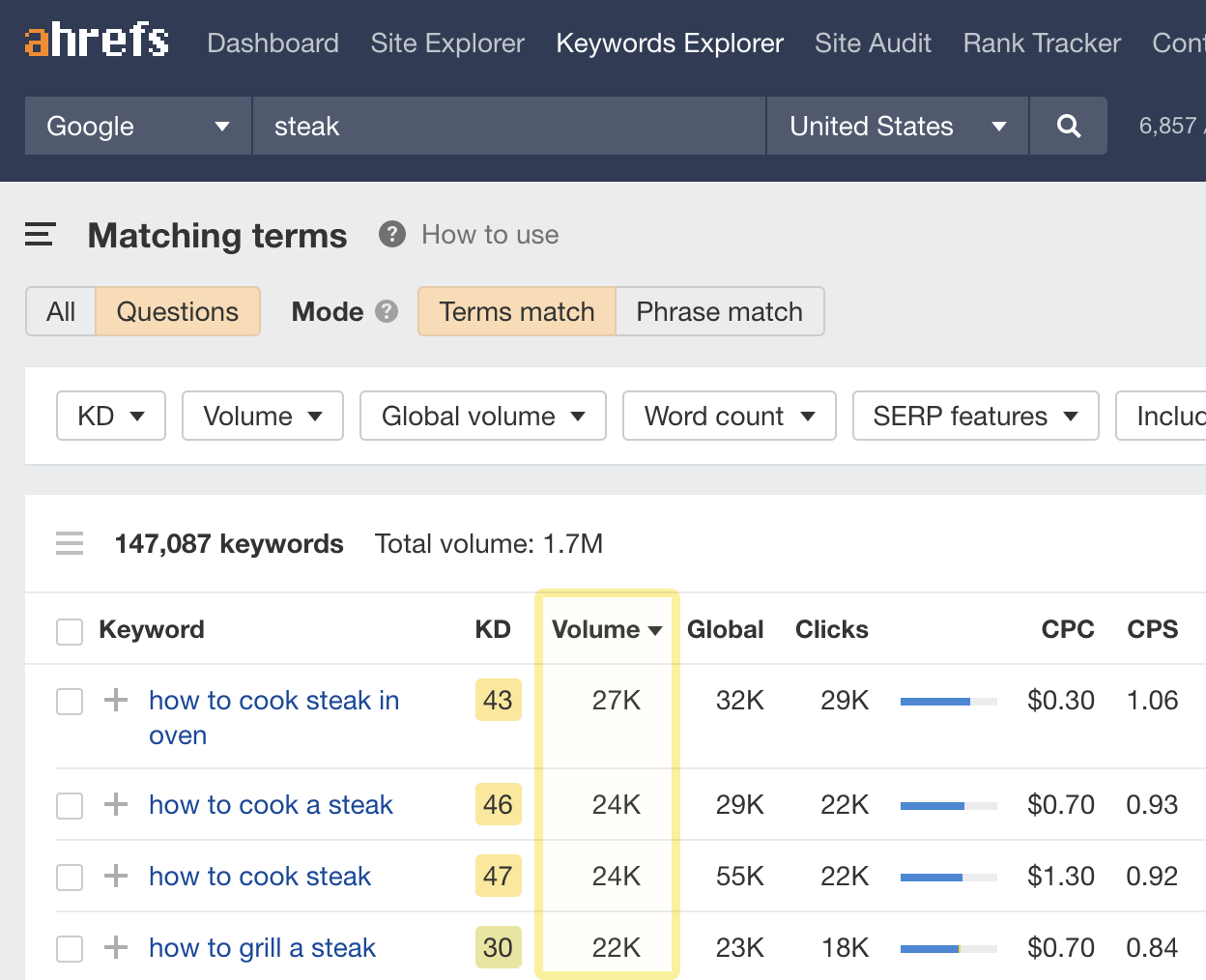
Generally speaking, the higher the search volume, the higher the traffic potential of the topic.
b) Look for questions with “business potential”
You can’t write a product-led blog post unless the topic allows you to pitch your product or service. We call this “business potential,” and we score all topics ideas using these criteria:
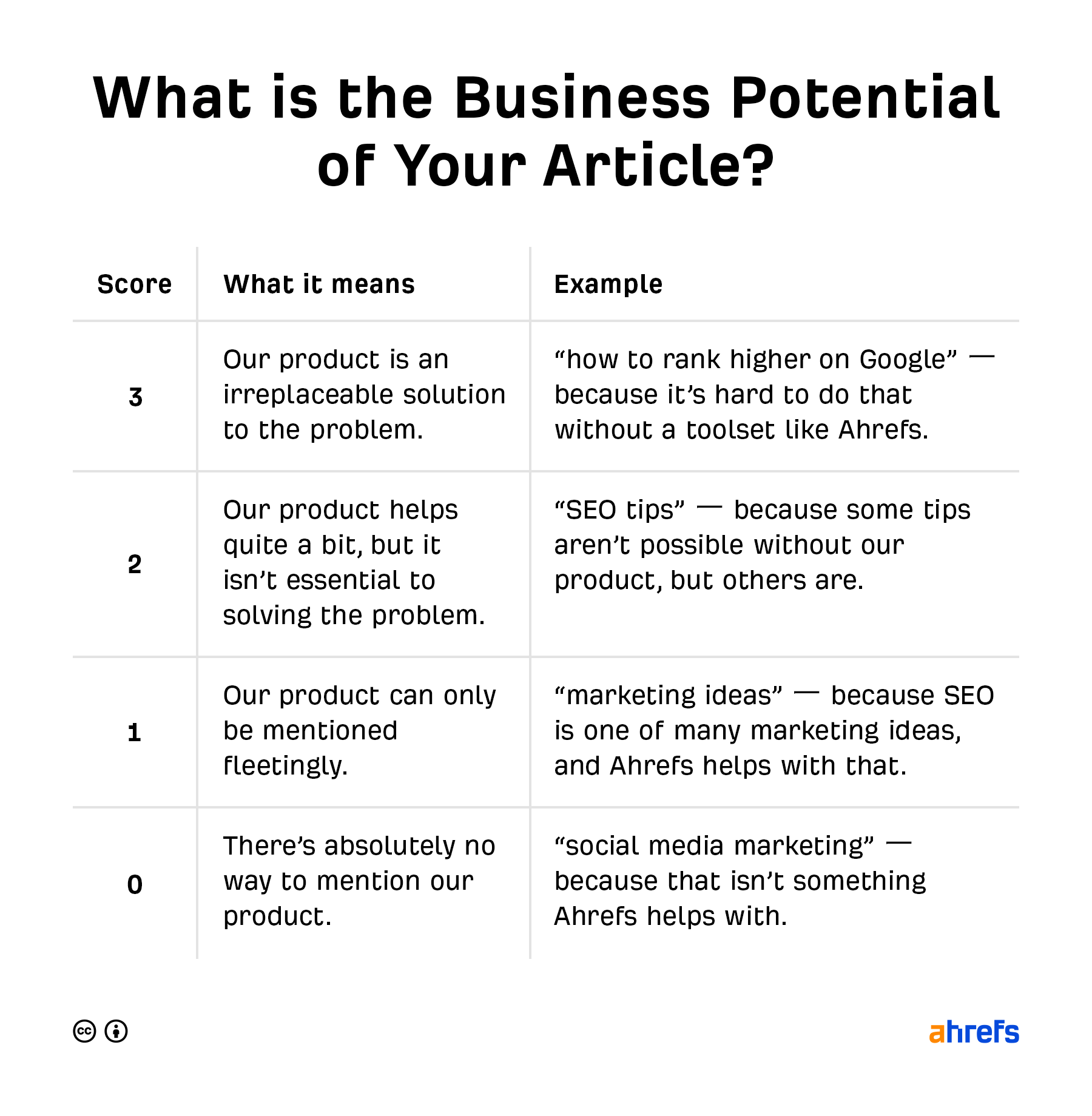
You should do this for any topics with search traffic potential.
For example, let’s say that you sell cast iron pans online. These topics would have high business potential…
- how to cook a ribeye steak (12K monthly searches)
- how to cook a flank steak (11K monthly searches)
- how to cook a steak in a pan (9.4K monthly searches)
- how to cook steak in cast iron skillet (8.6K monthly searches)
… whereas these topics would have low business potential:
- how to grill a steak (22K monthly searches)
- how to reheat steak (14K monthly searches)
- how to marinate steak (10K monthly searches)
- how to season steak (8.8K monthly searches)
You can easily pitch your product in posts about the topics with high business potential, whereas you’ll struggle to do so in the topics with low business potential.
Recommended reading: How to Do Keyword Research for SEO
c) Create high-quality content that deserves to rank
If you want to rank in pole position, you’ll need to write content that’s comprehensive and high-quality. Follow the advice in the guide below to learn how to do that.
Recommended reading: How to Write Content that Ranks
2. Create engaging videos
The videos on our YouTube channel have had over 12 million views, and our channel has 259K subscribers:
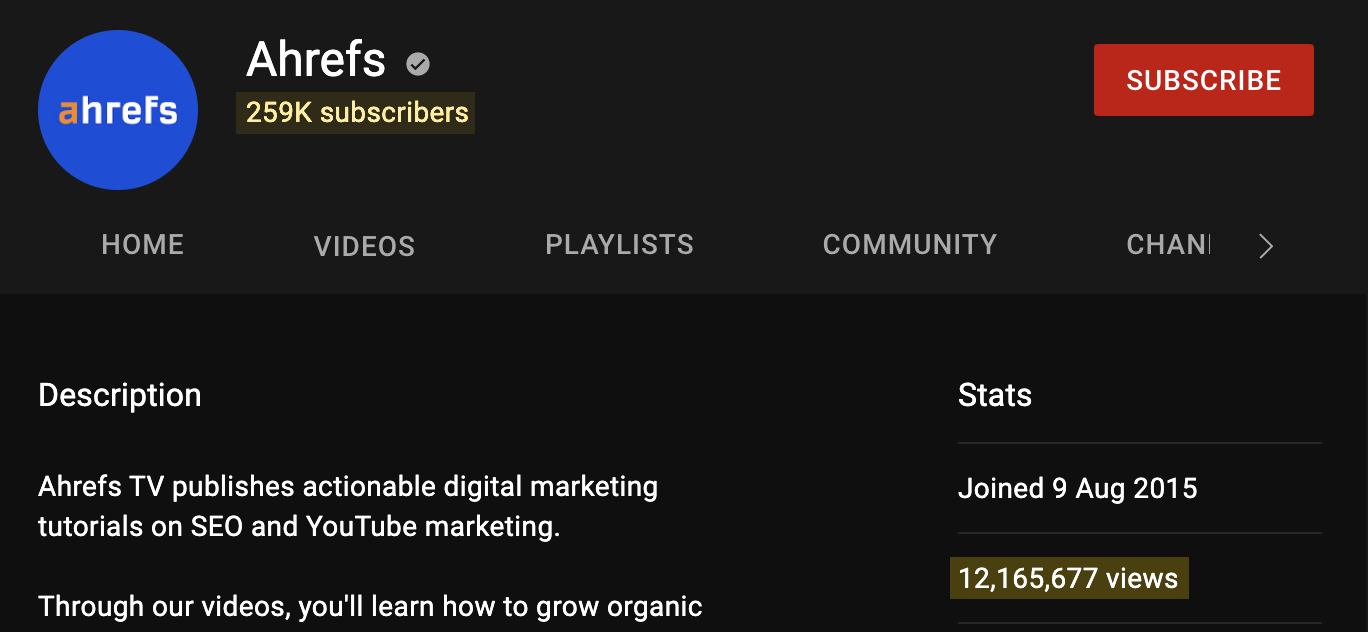
We did this by applying the same philosophy as our blog to our YouTube channel—we create product-led videos about topics with search traffic potential to generate demand for our products.
Here’s how you do it too:
a) Find video topics with search traffic potential
Here’s how:
- Go to Keywords Explorer
- Switch the search engine to “YouTube”
- Enter a “seed” keyword related to your niche
- Go to the Matching terms report
- Toggle the Questions tab
You’ll see a list of keywords and their estimated monthly search volumes on YouTube:
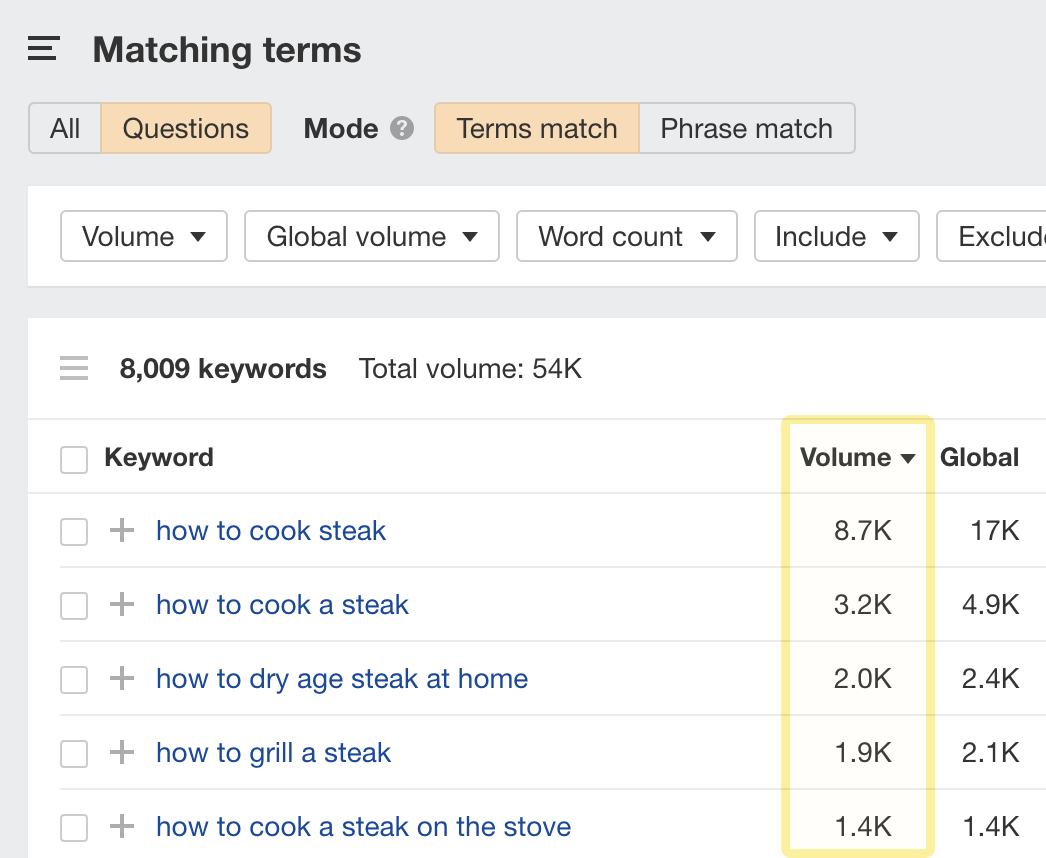
b) Choose topics with “business potential”
As with blog posts, it’s important to choose video topics with the potential to pitch your product or service. Follow the instructions in the previous section to learn how to do that.
c) Create an engaging video
Engaging videos are crucial for ranking high and gaining traction on YouTube. Watch this video to learn how to do that:
https://www.youtube.com/watch?v=j5EOWffq-gk
d) Publish regularly and encourage users to subscribe
Create a series of helpful videos that follow on. Encourage people to subscribe, so they don’t miss out on any helpful tips.
Recommended reading: 9 Ways to Get More YouTube Subscribers
3. Build free tools
Excluding our free WordPress SEO plugin and Ahrefs Webmaster Tools (AWT), we have ten free SEO tools:
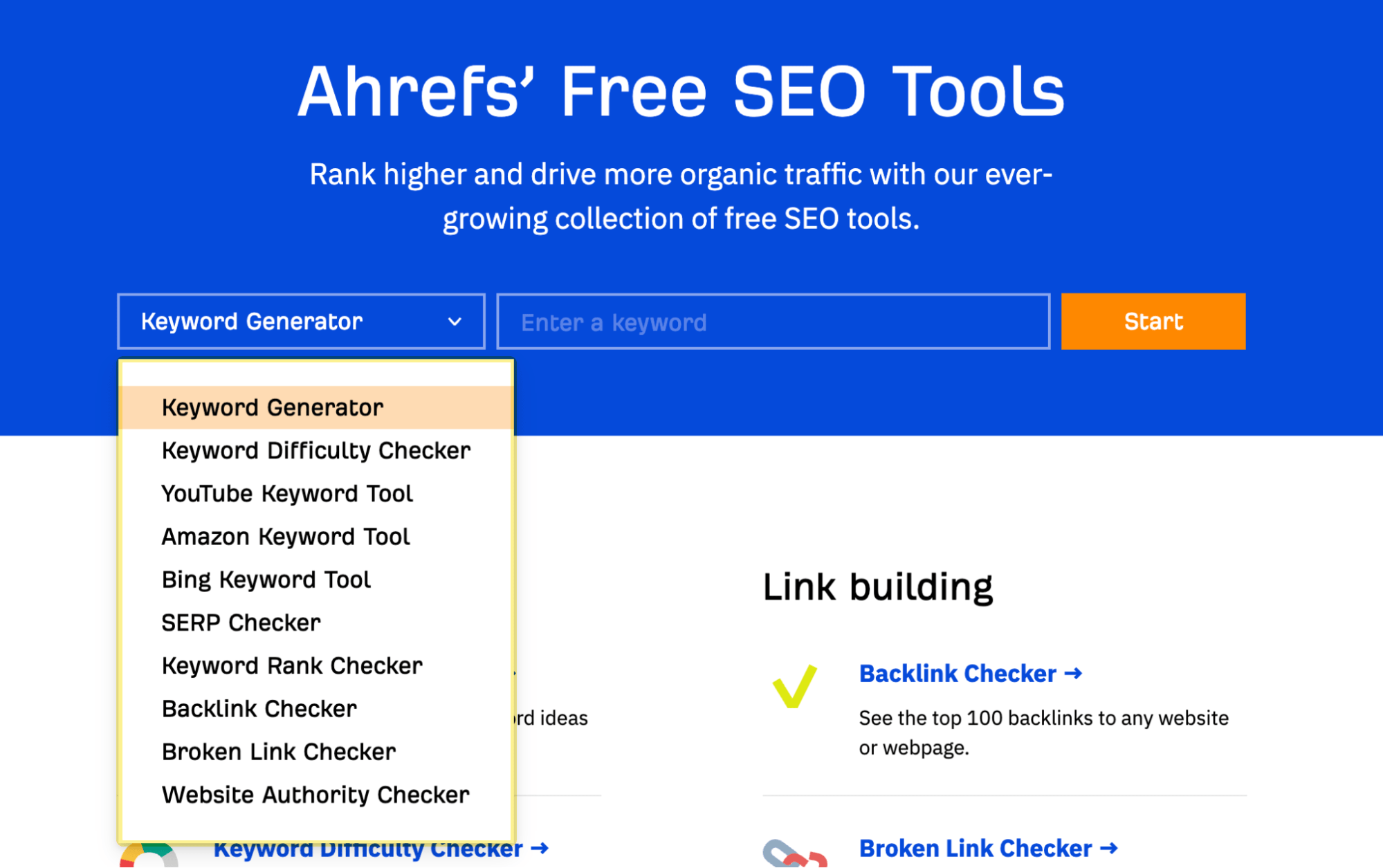
Combined, these tools get almost 300K monthly organic visits:

That means tens of thousands of people are getting a taster of how our products work every month. So it probably comes as no surprise that they generate plenty of demand and send plenty of new signups our way:

Here’s how to use free tools to generate demand for your business:
a) Find relevant tools that people are searching for
Here’s how:
- Go to Keywords Explorer
- Enter one or more “seed” keywords related to your niche
- Go to the Matching terms report
- Click the Include filter
- Toggle Any word
- Enter words like calculator, checker, tool (separated by commas)
You should then see keywords that represent tools people are searching for.
For example, here’s what an accountant might see for the seed keywords “tax,” “salary,” and “payroll”:

Many of those keywords have high search volumes, meaning that you could likely get lots of free traffic by creating and ranking tools for them.
b) Create a free tool
The best way to do this is to look at the top-ranking free tools for your target keyword and think about how they could be better. The better your free tool is, the easier it will be to promote.
c) Promote your free tool
You might have noticed that most of the keywords above have high Keyword Difficulty (KD) scores. If you see the same for your keyword, you’ll probably need a lot of backlinks to your tool before it ranks high in Google.
There are many ways to build backlinks. However, if you’re new to link building, we recommend reading the beginners guide below.
Recommended reading: The Beginner’s Guide to Link Building
4. Create courses
The Ahrefs Academy is currently home to four courses.
Each one lasts between two and seven hours and offers viewers a structured path to learning a particular skill. For example, our Blogging for Business course teaches you how to grow your blog past 100K monthly visitors and turn thousands of your readers into paying customers:

The course covers why most blogs fail, how to find content ideas, how to promote blog posts—everything you need to know to start and run a successful business blog.
And it generates demand by showing how Ahrefs can help with the task at hand:

Here’s how you can use courses to create demand for your business:
a) Identify your most popular content
Use Google Analytics to identify your most viewed content. If you don’t use Google Analytics, you can use the Top Pages report in Site Explorer for a rough idea:
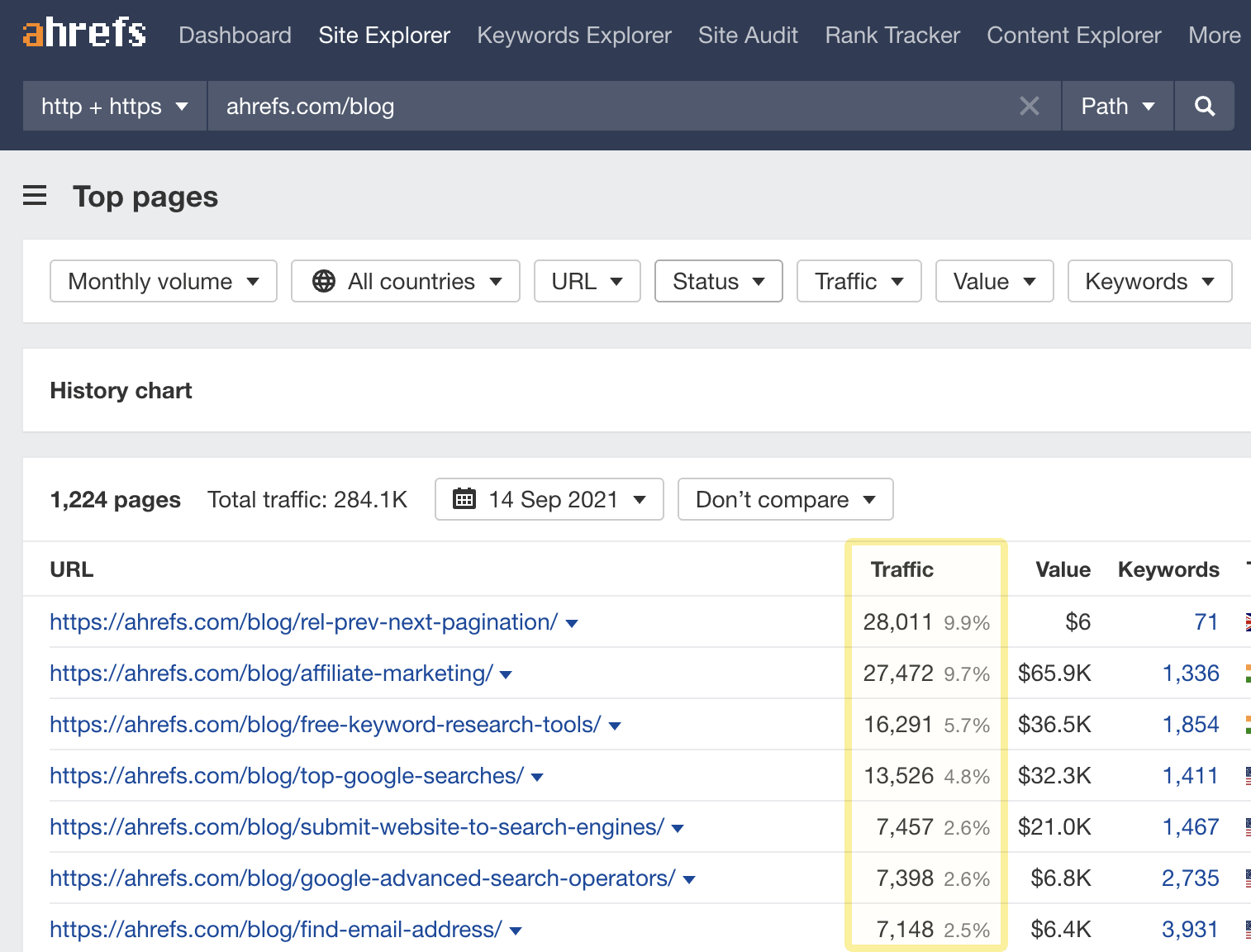
b) Build a course around the most popular topic
Group your top blog posts by topic, then create an online course around a popular one.
For example, the most popular topics on our blog are SEO and blogging. We have courses about both of these topics.
c) Promote the course in relevant blog posts
People don’t usually search for courses in any considerable volume in Google, so you need another way to drive course traffic and signups. One of the methods we use is to “promote” relevant courses at the end of relevant blog posts.
Here’s an example from the conclusion to our guide to blog SEO:
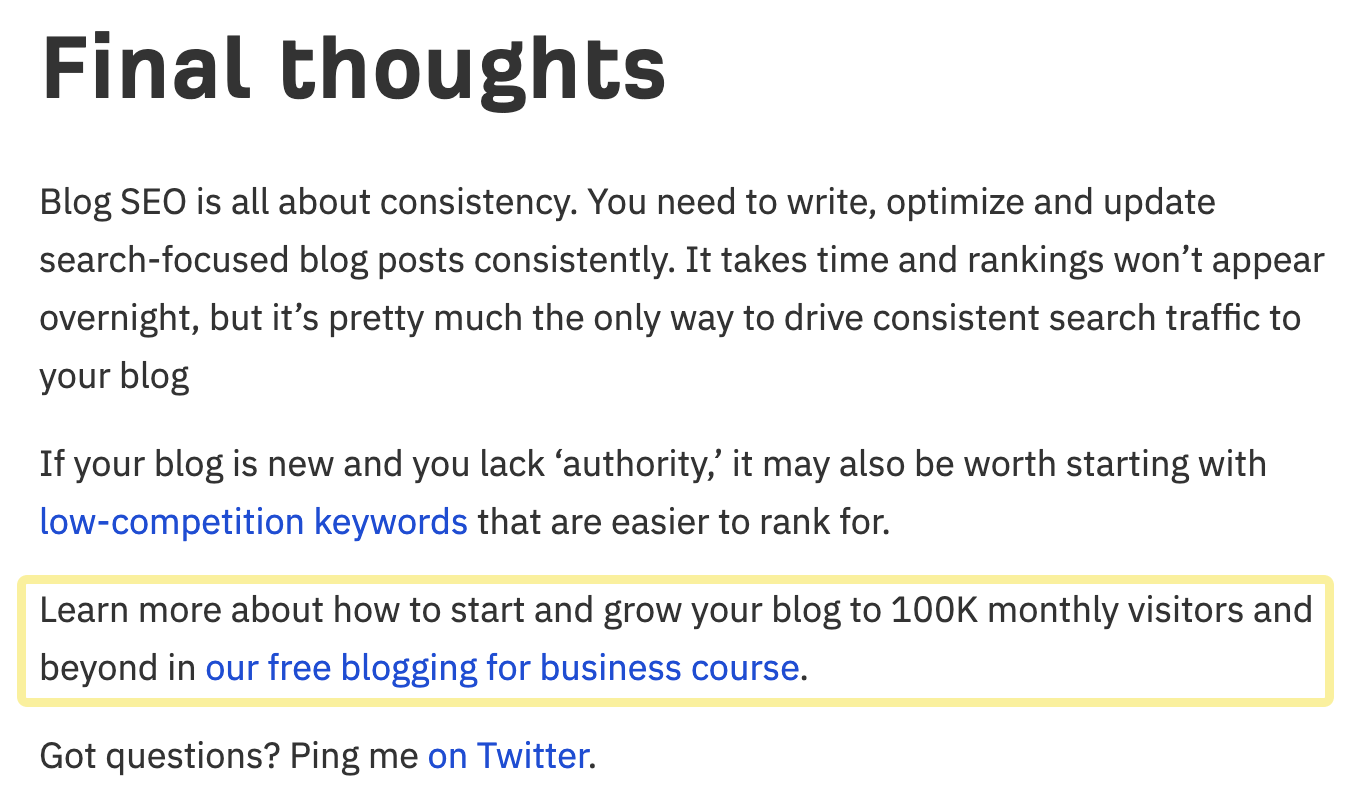
5. Be a guest on industry podcasts
In this podcast episode, our CMO Tim talks about how Ahrefs got to +$50M in ARR with +65% year-on-year growth by ditching expert advice and embracing unconventional wisdom:
He explains how we did it, our marketing strategy, and our content playbook.
Listeners might not be aware of Ahrefs and all the different ways the platform can help them improve their SEO. By telling them about the Ahrefs journey, Tim makes listeners aware of Ahrefs, its success, and how the platform could help them.
Here’s how to use podcasts to generate demand for your business:
a) Find industry-relevant podcasts
The easiest way to find these is with a Google search for “[industry] podcasts,” You’ll almost always see a bunch of lists in the search results, and Google sometimes even displays names of relevant podcasts from the Knowledge Graph in a SERP feature:

If these lists don’t give you enough podcasts, here’s a way to find more:
- Look for a prolific podcaster in your industry (you’ll often come across these as you look through industry podcasts)
- Paste that person’s domain into Site Explorer
- Go to the Backlinks report
- Filter for backlinks with their name in the Ref. page title
Many of the results will be backlinks from podcast episodes, which you can usually identify by the title and URL of the referring page:
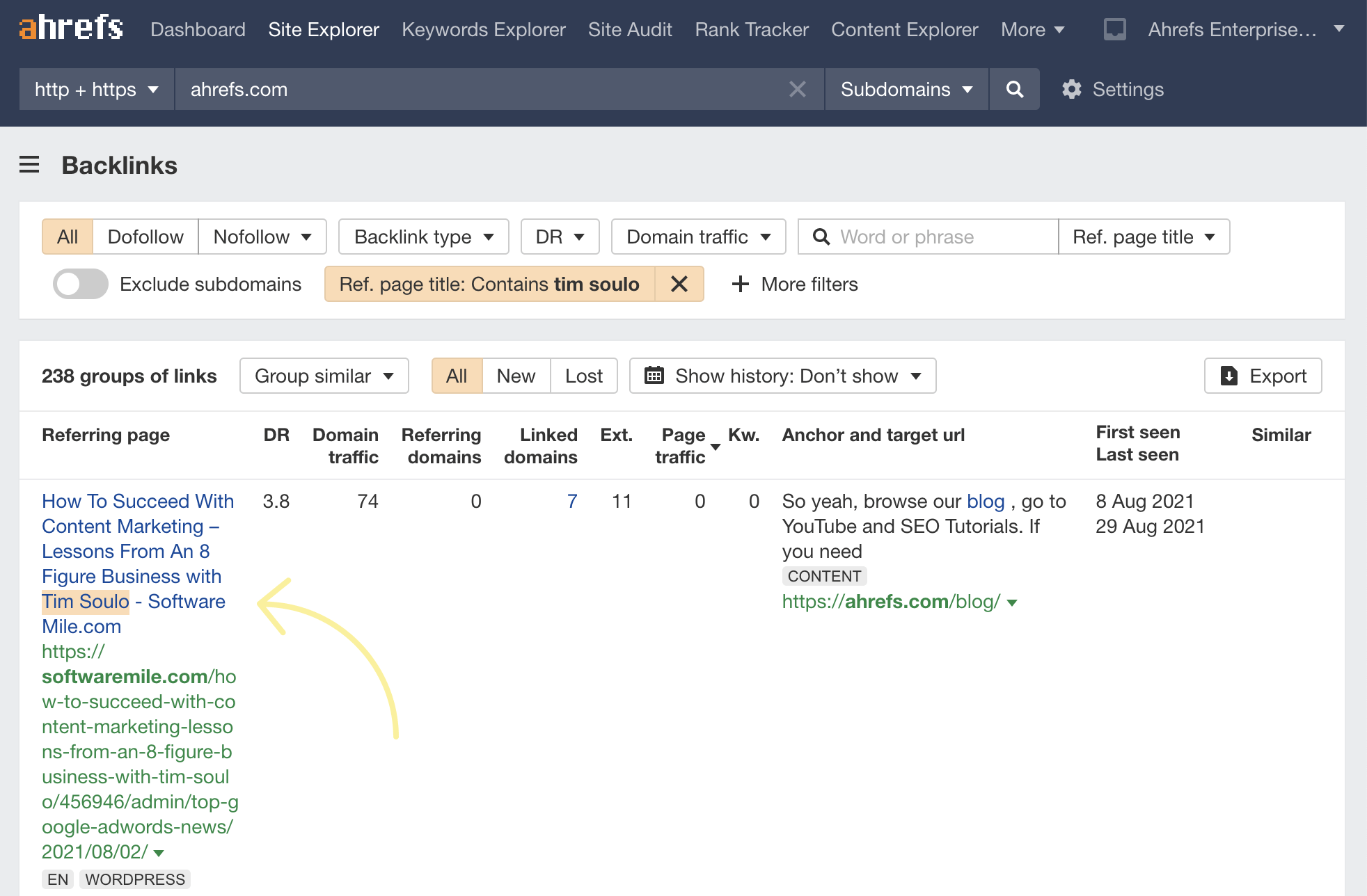
b) Network with key individuals
Before you drop straight into the podcaster’s inbox, spend some time getting to know them organically on Twitter, LinkedIn, or any other social platform they spend time on. That way, you’ll already be on their radar when you send them a pitch.
c) Pitch to be a guest
Find the email address of the podcast host, then pitch yourself as a guest.
bonus tip — use podcast booking services
Make yourself available as a podcast guest by signing up for a podcast booking service. Sites like PodcastGuests and Podchaser Connect link those who want to find podcast guests with those who want to be podcast interview guests.
Final thoughts
Successful demand generation tactics all build awareness and attract people to your product.
They capture your audience’s attention before they’re even looking for your product. That way, when they need a solution to their problem, your product is front of mind.
Got questions? Ping me on Twitter.
